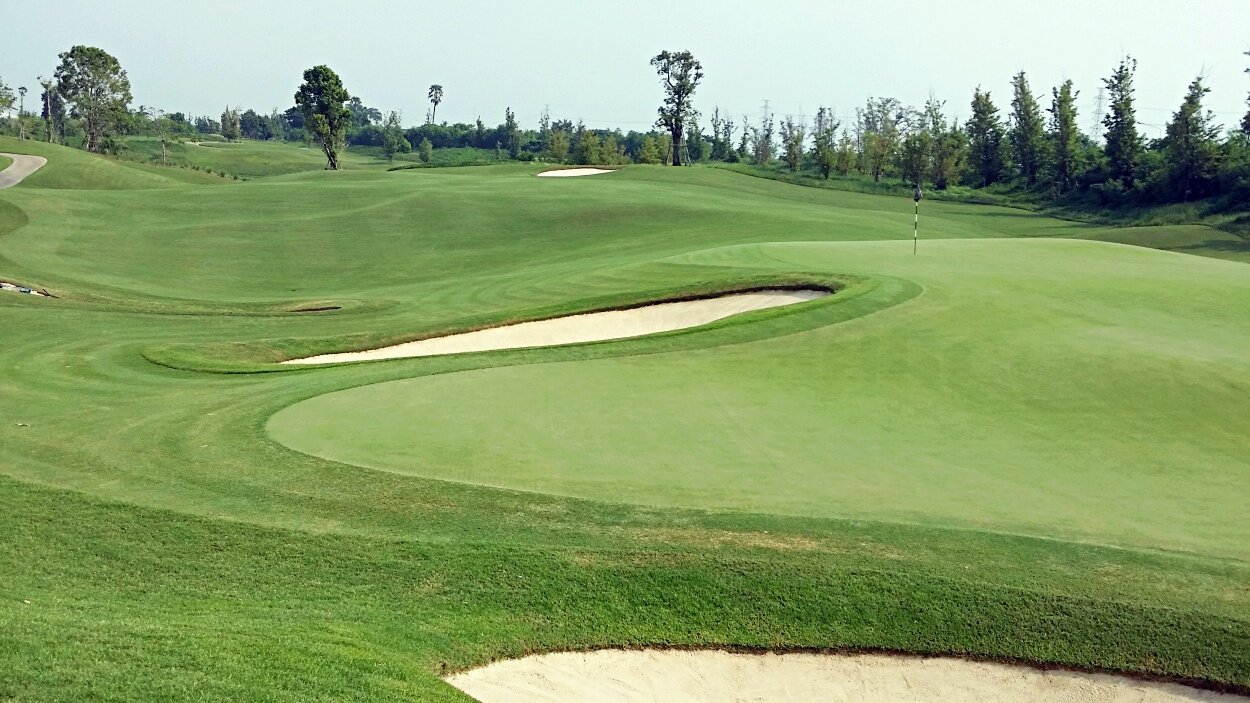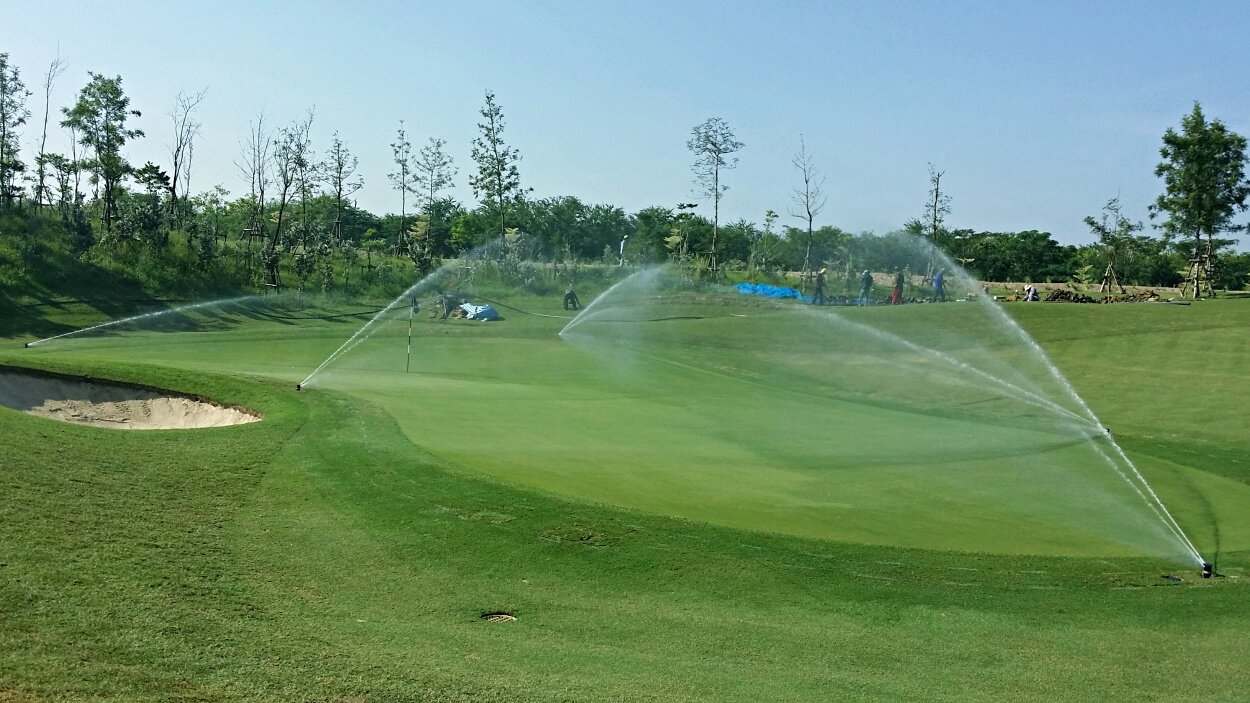NIKANTI GOLF CLUB - REAPING BENEFITS OF RECENT IRRIGATION UPGRADE
Nikanti Golf Club in Nakhon Pathom, Thailand, just outside of Bangkok, is reaping the benefits of their recent irrigation upgrade. Even though the course hadn’t even been officially opened the inadequacies of the original installation showed up quickly. The limitations included:
Undersized mainline and pump station resulting in excessive watering window.
Dead end mainline on some holes resulting in limited flow capacity and low pressure in many areas.
Excessive and irregular spacing with poor uniformity.
Poor sprinkler locations and nozzling with fairway sprinklers throwing well onto green surfaces.
Multiple sprinklers paired together (2 – 4) compounding the poor sprinkler spacing and low pressure.
Poor green sprinkler layout, locations and uniformity. Sprinklers from off the greens throwing onto the greens, limited surround sprinklers around and behind many greens and poor green sprinkler locations causing overwatering of the approach and green surfaces.
Poor tee and fairway sprinkler layout and excessive spacing.
As a result, the course was suffering from:
Wet and dry spots
Excessive salt buildup
Algae on greens, approaches and fairways
Inability to apply adequate irrigation during peak demand
Excessive power and water use
Poor turf quality
Unsatisfactory playability
The golf course design at Nikanti Golf Club is not your typical flat course as many in the Bangkok area are. The course features significant undulations in the fairways, roughs and even some greens with large runoffs from many of the elevated greens. The irrigation system in conditions such as these requires an even higher degree of control to have the capability to adapt the application rate to meet the diverse conditions. The original irrigation system was not designed to meet these challenges.
Significant Undulations In the Fairways, Roughs and Even Some Greens With Large Runoffs From Many of the Elevated Greens Create Many Irrigation Challenges.
ATI was initially contacted by Hamish McKendrick (Agronomist) and Brad Revill (Golf Course Superintendent) to perform an Irrigation System Analysis and Long Range Plan. The purpose of the analysis was to help independently identify the problems and make recommendations to the ownership to remedy the problems. Unfortunately, at the time the system was less than a year old and the course not yet open for play. Accepting these limitations and significant additional costs was difficult to explain and for the ownership understand initially.
However, after reviewing the findings of the system analysis submitted by ATI and seeing the poor conditions the ownership wisely committed to implement most of the ATI recommendations. J & J, the local Toro distributor, was contracted to implement the upgrade designed by ATI.
ATI prepared an irrigation renovation plan to include the following:
Installation of a new Watertronics 681 m3/hr at 8.27 bar (3,000 gpm @ 120 psi) with capacity for a possible future expansion. A significant increase from the original 375 m3/hr at 8.27 bar (1,650 gpm @ 120 psi pump station.
Supplemental mainline and increased mainline size in selected areas to increase flow and reduce pressure loss. The additional main provided looping of the previous dead ends as well.
Conversion to individual sprinkler control by adding additional decoders. To accomplish the individual control supplemental decoder communication wire was required due to limitations in the capacity of the original wire installed.
Installation of complete new green and surround irrigation.
Fortunately, the contractor and golf course working together allowed these significant renovations to be installed with limited disruption to play.
One year after completion of the renovation the results are obvious when you drive into the property not to mention the tremendously improved playing conditions. The benefits in the investment in the irrigation system include:
Healthier turf
More consistent and not excessive soil moisture.
Greatly improved playability
Reduced water useand electrical consumption
More uniform greens moisture and no algae on greens, approaches or fairways
Reduced salt buildup in the fairways and roughs
Improved turf and playing conditions.
The new system has given Brad Revill the tools he needed to dial in the course conditions. Brad and his staff can now implement much more controlled and precise water applications. They only irrigate what is needed and not until it is needed. This improved water management is accomplished through a combination of the following management practices:
Constant visual observation and awareness
Soil moisture sensing
A disciplined irrigation scheduling regimen
Hand watering as needed for small areas
The improved water management was the result of the disciplined management provided by Brad Revill, the golf course superintendent. Golf courses in Asia in general and Thailand in particular suffer greatly from significant overwatering. The reason for this general overwatering can vary from course to course, but are a result to some degree of the following factors:
Fear of brown grass
A lack of understanding of playability and golfer happiness
Fear of computers combined with a language barrier to operate the software
Apathy
In order to overcome the urge to overwater the staff at Nikanti required a change in their mindset. Brad laid down strict guidelines to not irrigate anything until necessary which required “training them up or kicking some ass,” according to Brad. He instructed the staff not to panic when they saw a dry spot. Before, if one fairway had one dry spot, then ALL the fairways would be irrigated and not just the area(s) in need. Brown spots are a good sign, not a bad sign. They show that we are where we want to be and then implement the appropriate action to only that area in need and only the amount needed. Keeping the course on the edge of dryness rather than excessively wet requires:
An understanding of soil moisture levels and their effects on turf
Keen attention to the status of the soil moisture and turf condition
Discipline to only apply water where it is needed, at the right time and at the right amount
Knowledge of the irrigation system to determine the best method of action to replace address dry areas, whether by hose, by a single sprinkler or a group of sprinklers. Start with the smallest option and work your way up.
At Nikanti, the soil moisture sensing begins in the morning with the Spectrum TDR moisture sensing probe to gather the data for the greens. When they hand water the greens in the mornings from a quick coupler and hose, the minimum soil moisture level is dependent on weather conditions, but generally ranges from around 15% to 17%. A decision is made on this daily. At midday, a Pogo moisture sensing probe is used to further measure the soil moisture. If the reading is 10 – 15% or less the dry areas are hand watered again and evening irrigation scheduled. When they schedule the irrigation at night using the Pogo Cloud GPS mapping they only turn on the sprinklers that directly influence the dry areas. The Pogo offers the benefit of easily tracking and recording the data in the computer. The Spectrum TDR is used in the morning since the time required is less than with the Pogo. The two instruments take measurement at different depths which is helpful with the Spectrum measuring at a deeper level. As a result the readings are slightly different but both are beneficial. The use of the soil moisture sensing removes the subjective nature of the process which makes the task much easier for the staff to understand.
Soil moisture sensing with Pogo.
Hand watering of greens when needed.
The improved irrigation on the greens provides much more uniform coverage of the water than before. Eliminating water from fairway and other sprinklers throwing onto the greens makes the management of the green soil moisture much easier to control. This coupled with the improved water management has eliminated the algae on the greens. Additionally, the approaches to the green are much drier than before so the playability of the course has greatly improved.
The weather station is used to track the weather and evapotranspiration rate (ET). The correct amount of water required is then scheduled for the other areas of the course. In the dry season the maximum they would apply at peak would be 7 – 9 mm. A full irrigation cycle can now be applied in dry season from 7:30 pm to 4:00 am to the entire course as a result of the increase pump and mainline capacity. Before the renovation it wasn’t possible to adequately irrigate the entire course in a single evening during peak demand.
Daily field adjustments of individual sprinkler run times.
The upgraded individual sprinkler control now allows the staff to adjust the sprinkler run times up or down on a daily basis as needed for each sprinkler based on their visual observation during the day. The graphic as-built map added to the computer when it was programmed by ATI is a significant benefit to the operation of the system. After identifying wet and dry spots the use of the graphic as-built map with the IPad makes the task revising the program much quicker and simpler to accomplish. .
Most of the recommendations from the ATI System Analysis and Long Range Plan were implemented during the initial irrigation renovation. However, a couple of other improvements are still on the list to be accomplished as soon as the funding becomes available. The rough areas around the tees are planted with a combination of landscape and native grasses. This is a great idea to help conserve water, reduce maintenance and provide an attractive contrast to the turf. Unfortunately, during the initial irrigation installation these areas were irrigated with the same sprinklers as the turf. Water is now wasted in these areas and the unnecessary water promotes weed growth causing additional and unnecessary work for the staff. Nikanti plans to upgrade the irrigation in these areas to tee top only irrigation as soon as possible.
The addition of tee top only irrigation in the future will further improve water efficiency and reduce unnecessary growth and weeds.
Also, many of the bunkers at Nikanti have steep grass down bunker faces so they dry much quicker than the surrounding turf. They require constant supplement hand watering to keep them in good condition. As soon as possible Nikanti intends to start adding supplemental sub-surface drip irrigation to the bunker faces in need. This can be added by the staff one at a time as time and money becomes available.
The investment in the irrigation system combined with the professional water management provided by Brad and his staff has paid off in improved course conditions, increased play, lower operating costs and improved customer satisfaction.
Uniform turf and improved playability.
If your course experiences similar problems or is not at the level of condition you desire a good start is to get a system analysis from ATI performed as soon as possible. You can then know what is required to give your staff the tools they need to do their job at a high level.
Unfortunately the poor spacing and location of the sprinklers in the fairways and roughs cannot be easily overcome. Fortunately for Nikanti some of the other mistakes could be repaired but improving poor sprinkler layout requires nearly starting over. The best answer for golf course, like most important tasks, is to do it right the first time.
Written by James Schumacher, President of Aqua Turf International. Original article can be found at http://www.aquaturfintl.com









